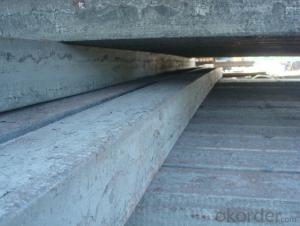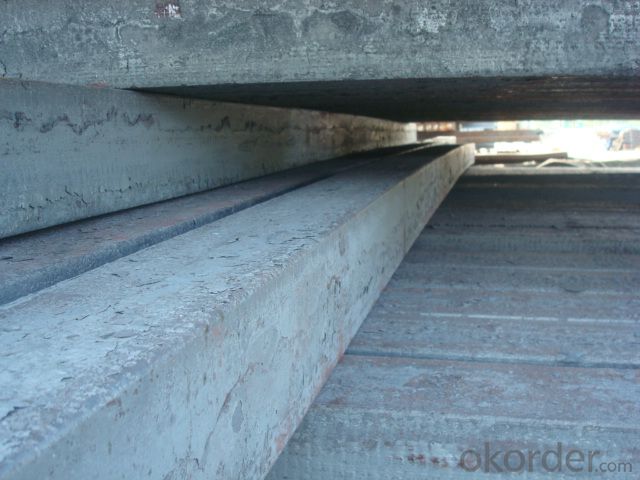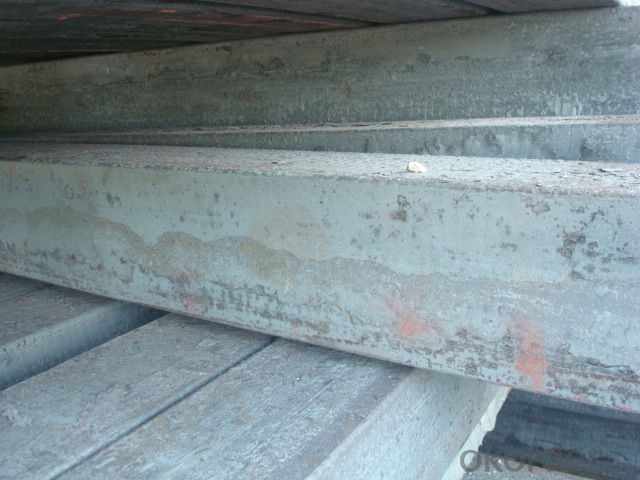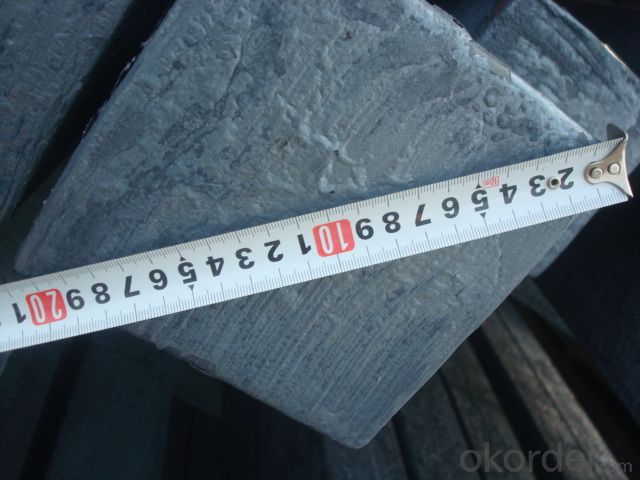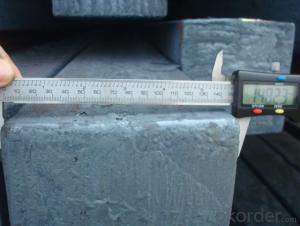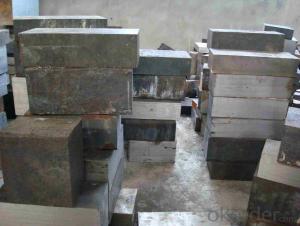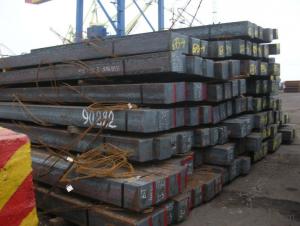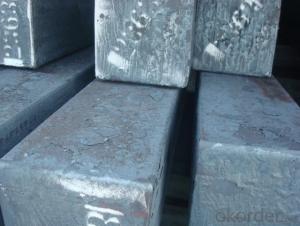Continuous Casting Steel Billet Q275 in Amazing Price
- Loading Port:
- Tianjin
- Payment Terms:
- TT OR LC
- Min Order Qty:
- 1000 m.t.
- Supply Capability:
- 200000 m.t./month
OKorder Service Pledge
OKorder Financial Service
You Might Also Like
STEEL BILLET
1.Structure of Steel Billet
Steel billet(ingot) by cogging or breakdown of semi-finished products, is the raw material of all kinds of steel mill. Billet section of square, round, flat, rectangular and abnormity of several kinds of, mainly related to the shape of rolled products.
2.Main Features of Steel Billet
Rectangular billet continuous casting billet and mainly general carbon steel, low carbon low silicon cold-rolled material, high quality carbon structural steel, high strength low alloy steel, special steel, etc.
The billet is mainly divided into two kinds from the shape:
Slab: cross section width and height of the ratio of the larger, mainly used for rolling plate.
Billet: equal cross section width and height, or a huge difference, mainly used for rolling steel, wire rod. ,
Steel billets have distinct characteristics as compared with already furnished steel bars and products. Billets have a specific grain structure, which enables the metal to be processed more intricately. Steel billets are also known for their malleability and ductility, especially when exposed to varying temperatures during shaping and molding.
3.Processing of Steel Billet
Steel billets are considered fresh and raw, and they must undergo a series of manufacturing processes before they can be used for various purposes. Billets are made by means of freezing molten liquid, and are later exposed to extremely low temperatures in order to allow the metal to take shape and solidify in chemical structure. The temperature manipulates the metal's physical properties, and tones its strength and durability. The subsequent processes provide the metal's curved mold design so that it can fit the allotted space provided by other machines, which complete the finishing procedures.
4.Steel Billet Images
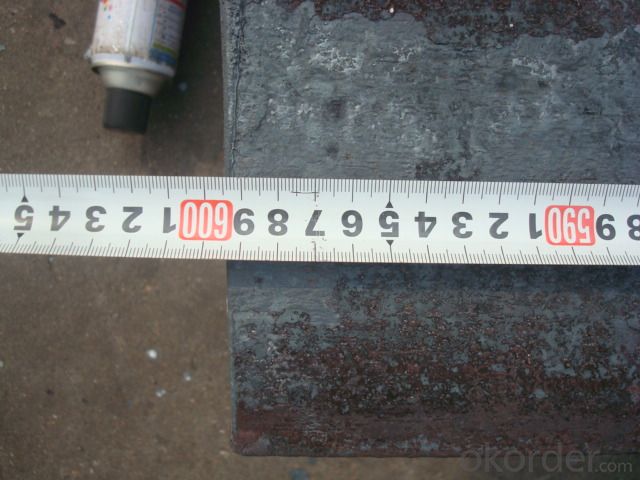
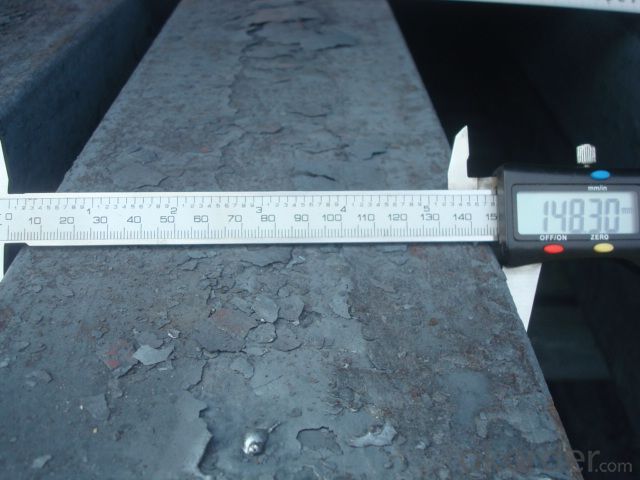
5.Usage of Steel Billet
Billets, or ingots (as they sometimes referred to), are not of practical use until they have been formed into more functional shapes and sizes. While they have already been put in the furnace, they still require a series of shaping and molding procedures such as hot and cold working, milling and cutting before they are sold in hardware stores, or used for different applications. The unformed billets, however, can be used in striking currency such as coins and as reserves, similar to gold bars.
6. Steel Billet Specification
Hot rolled billet steel
Size: 50x50mm-180x180mm
Steel Grade: 3SP, 5SP,Q195,Q235,Q255,Q275 Length:3m-12m
MOQ: 1000MT/size
Payment term: TT or LC
Packing: in bulk , bundle
Shipment: by container , bulk vessel
Packaging Details: bundles with steel strips or as customers's requirements
Delivery time: 15-30 days after the deposit
Loading port:Tianjin, or other port China
Origin :China
Inspection:Third party inspection before loading.
7.FAQ
We have organized several common questions for our clients,may help you sincerely:
1) How about your company?
A world class manufacturer & supplier of castings forging in carbon steel and alloy steel,is one of the large-scale professional investment casting production bases in China,consisting of both casting foundry forging and machining factory. Annually more than 8000 tons Precision casting and forging parts are exported to markets in Europe,America and Japan. OEM casting and forging service available according to customer’s requirements.
2) How to guarantee the quality of the products?
We have established the international advanced quality management system,every link from raw material to final product we have strict quality test;We resolutely put an end to unqualified products flowing into the market. At the same time, we will provide necessary follow-up service assurance.
3) How long can we receive the product after purchase?
In the purchase of product within three working days, We will arrange the factory delivery as soon as possible. The pecific time of receiving is related to the state and position of customers.Commonly 7 to 10 working days can be served.
4)Do you have your own QC department?
Yes, we have, our QC department will inspect the goods during the process of mass production and after completion of production.
5)If there’s something wrong with the quality of the products, how do we return the goods?
We promise you the quality will be the same as the samples you confirmed. If there’s something wrong with the quality of the products, please send back sample from the shipment goods to us and let us know the quantity, then we will investigate in our work shop. If it is our problem, we will offer you discount or replacements for free.
- Q: What are the common applications of steel billets?
- Steel billets are semi-finished products that are used in various industrial applications. Some of the common applications of steel billets are: 1. Construction: Steel billets are widely used in the construction industry for structural purposes. They are used to manufacture beams, columns, and other load-bearing components in buildings, bridges, and other structures. The high strength and durability of steel billets make them ideal for withstanding heavy loads and providing structural integrity. 2. Automotive Industry: Steel billets are extensively used in the automotive industry for manufacturing various components such as crankshafts, camshafts, connecting rods, and gears. The excellent mechanical properties of steel billets ensure the reliability and performance of these critical automotive parts. 3. Machinery and Equipment Manufacturing: Steel billets are used in the production of machinery and equipment. They are utilized for manufacturing parts like gears, shafts, valves, and hydraulic cylinders. The versatility of steel billets allows for the customization of these components to meet specific operational requirements. 4. Electrical Industry: Steel billets find applications in the electrical industry for the production of electrical transformers and electric motor cores. The high magnetic permeability and electrical conductivity of steel make it an ideal material for these applications. 5. Pipe Manufacturing: Steel billets are commonly used in the manufacturing of pipes and tubes. They are processed through various techniques such as hot rolling, cold rolling, and extrusion to produce seamless or welded pipes. The strength and corrosion resistance of steel billets make them suitable for transporting fluids and gases in industries like oil and gas, water supply, and construction. 6. Shipbuilding: Steel billets are crucial in shipbuilding due to their strength, durability, and resistance to corrosion. They are used to manufacture various ship components such as hulls, frames, and bulkheads. The ability of steel billets to withstand harsh marine environments makes them an ideal choice for constructing ships and offshore structures. Overall, steel billets are versatile materials that find applications in a wide range of industries, thanks to their excellent mechanical properties, durability, and ability to be customized to meet specific requirements.
- Q: How do steel billets contribute to the food processing industry?
- Steel billets contribute to the food processing industry in several ways. Firstly, steel billets are used to manufacture various machinery and equipment used in the food processing industry. For example, they are used to create conveyor belts, mixers, crushers, and packaging machines, among others. These machines play a crucial role in the processing, handling, and packaging of food products. Steel billets are also used to produce storage tanks and containers, which are essential for the safe and hygienic storage of food ingredients and finished products. These tanks are usually made of stainless steel, which is corrosion-resistant, durable, and easy to clean, ensuring that the food remains uncontaminated and of high quality. Furthermore, steel billets contribute to the construction of infrastructure in the food processing industry. They are used to build food processing plants, warehouses, and cold storage facilities. These structures provide the necessary environment for food processing, such as temperature control and proper ventilation, ensuring food safety and preservation. Additionally, steel billets are crucial for the transportation of food products. They are used to manufacture shipping containers, refrigerated trucks, and railway cars, which enable the efficient and safe transportation of food from one location to another. The strength and durability of steel ensure that the food products are protected during transit, preventing spoilage and contamination. Overall, steel billets are essential in the food processing industry as they contribute to the manufacturing of machinery, storage containers, infrastructure, and transportation systems. Their properties of strength, durability, and corrosion resistance make them ideal for ensuring food safety, quality, and efficiency in all stages of food processing.
- Q: Can steel billets be used in the production of agricultural equipment?
- Yes, steel billets can be used in the production of agricultural equipment. Steel billets are versatile and strong, making them suitable for manufacturing various components of agricultural machinery such as plows, harvesters, and tractors. The use of steel billets ensures durability, reliability, and resistance to corrosion, making them a preferred material choice in the agricultural industry.
- Q: How are steel billets transported internationally?
- Depending on factors such as distance, quantity, and urgency, steel billets are transported internationally by various means. Popular methods include shipping, rail, and road transportation. For long-distance international transport, shipping is the preferred choice. Steel billets are loaded into shipping containers, typically 20-foot or 40-foot in size, and secured to prevent movement during transit. These containers are then transported by cargo ships, which offer large storage capacities and efficient transportation over vast distances. Designed to protect the steel billets from external elements like moisture and corrosion, shipping containers ensure their integrity upon arrival. Rail transport is also commonly used for international shipments, especially to destinations connected by rail networks. Steel billets are loaded onto railcars, either in open-top or covered wagons depending on requirements and weather conditions. Rail transportation is favored for its cost-effectiveness, ability to handle large volumes, and access to landlocked regions. For shorter distances or urgent deliveries, road transportation is employed. Steel billets are loaded onto flatbed trucks or trailers, securely fastened to prevent any movement, and transported directly to their destination. Road transport offers flexibility, allowing delivery to locations where other modes may face limitations. Regardless of the transportation mode, international shipments of steel billets must have proper documentation, including customs clearance, bill of lading, and other relevant paperwork. These ensure compliance with international trade regulations, smooth border crossings, and timely delivery of the steel billets to their destination.
- Q: What are the different types of steel billet rolling mill automation systems?
- There are several different types of steel billet rolling mill automation systems that are commonly used in the industry. These systems are designed to improve the efficiency, accuracy, and overall productivity of the rolling mill operations. Here are some of the most commonly used automation systems: 1. Level 1 Automation: This is the basic level of automation that includes basic control and monitoring functions. It typically involves the use of programmable logic controllers (PLCs) to control and monitor various aspects of the rolling mill, such as speed, temperature, and pressure. This level of automation provides basic functionality but may require manual intervention for certain tasks. 2. Level 2 Automation: This level of automation goes beyond the basic control and monitoring functions of level 1. It includes advanced process control algorithms and models to optimize the rolling mill operations. Level 2 automation systems can automatically adjust the mill parameters, such as roll gap, roll speed, and cooling water flow, to achieve the desired product specifications. These systems also provide real-time process monitoring and data analysis capabilities. 3. Level 3 Automation: This level of automation focuses on the integration of the rolling mill with other systems in the plant, such as the material handling system and the quality control system. It includes features like automatic scheduling, inventory management, and seamless data exchange between different systems. Level 3 automation systems enable better coordination and synchronization of the entire production process, resulting in improved efficiency and reduced downtime. 4. Artificial Intelligence (AI) and Machine Learning: Some advanced automation systems leverage AI and machine learning algorithms to continuously learn from the data collected during the rolling mill operations. These systems can predict equipment failures, optimize production parameters, and even suggest process improvements. AI and machine learning-based automation systems enable proactive maintenance, better decision-making, and increased overall productivity. 5. Robotics and Robotics-assisted Automation: In some steel billet rolling mills, robots are used for various tasks, such as loading and unloading, quality inspection, and maintenance. Robotic automation systems offer precision, speed, and repeatability, reducing the need for manual labor and improving safety. These systems can be integrated with other automation systems to create a fully automated and efficient rolling mill operation. Overall, the different types of steel billet rolling mill automation systems offer varying levels of functionality and sophistication. The choice of automation system depends on the specific requirements of the mill, the desired level of automation, and the available budget.
- Q: What is the difference between steel and billet in the process?
- Square is a square steel hollow, with iron produced; but it is a square steel billet is generally solid, forging or casting molding.
- Q: What are the common alloys used in the production of steel billets?
- The common alloys used in the production of steel billets are primarily carbon and manganese. Carbon is added to increase the hardness and strength of the steel, while manganese is added to improve the steel's toughness and hardenability. Additionally, other alloying elements such as silicon, nickel, chromium, and vanadium may be added in smaller amounts to further enhance specific properties of the steel, such as corrosion resistance, heat resistance, or wear resistance. These alloying elements help create a wide range of steel grades with varying characteristics that can be tailored to suit different applications and industries.
- Q: How are steel billets used in the production of industrial pumps?
- Steel billets are used in the production of industrial pumps as they serve as the raw material for creating the pump's main components, such as the pump body and impeller. These billets are melted, cast, and then forged or machined into the desired shapes and sizes to form the pump's robust and durable structure.
- Q: What are the potential applications of steel billets in the electronics industry?
- Steel billets can be used in the electronics industry for various applications such as manufacturing electronic enclosures, brackets, and chassis for electronic devices. They can also be utilized for creating structural components and supports in electronic equipment. Additionally, steel billets are commonly used in the production of connectors, terminals, and pins for electrical connections.
- Q: What are the different types of surface defects found in steel billets?
- There are several types of surface defects that can be found in steel billets, including cracks, scabs, laps, seams, and surface pinholes.
Send your message to us
Continuous Casting Steel Billet Q275 in Amazing Price
- Loading Port:
- Tianjin
- Payment Terms:
- TT OR LC
- Min Order Qty:
- 1000 m.t.
- Supply Capability:
- 200000 m.t./month
OKorder Service Pledge
OKorder Financial Service
Similar products
Hot products
Hot Searches
Related keywords
